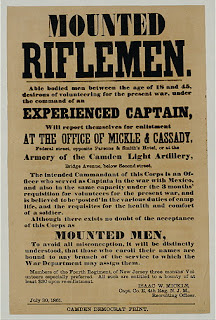Sneak Peek: Military Button Bingo
 |
| Courtesy of the Library of Congress |
So what about the buttons on the clothing we wear? Many Americans and others around the world find buttons fascinating, but why? Perhaps it is because buttons can tell us something about the people who wore them or even help us better understand ourselves.
When it comes to these little round objects, military buttons are probably one of the best examples of continuous change and seriation. Because militaries love uniforms and buttons often adorn them, buttons have been around since the invention of the modern professional soldier. In the case of the U.S. military, buttons have been in service since 1776 and have a long and rich history. So in the spirit of Archaeology Month and its emphasis on the Civil War, I would like to share with everyone a little bit about U.S. military buttons with a primary focus on those in use during and before the Civil War.
Because the military is made of many different groups with their own specific jobs and tasks, it is appropriate that each group would have their own unique button face. Each of the buttons tell us a little bit about each group in their design and decoration. Some organizations change their names and must have new buttons produced to reflect their new nomenclature, while others stay the same. For the purpose of this article, we will only look at some Infantry, Artillery and Mounted buttons.
The United States Infantry has a long tradition of being the backbone of military force in America’s conflicts. In the Civil War alone, some 2,000,000 men served as infantry. These men needed buttons and the archaeological record has analyzed and recorded many of the different variants that have existed. The design adopted in 1821 that depicted a spread eagle with a shield inscribed with an “I” was issued to enlisted men until 1854. The 1821 design saw action in the Civil War as officers still used the design until 1902 and veteran infantrymen still were in possession of the older buttons.
 |
| Courtesy of Digging In: the Historic Trails of Nebraska website |
Mounted troops first appeared in the U.S. military during the Revolutionary War when Light Dragoon contingents were organized to fight the British. After being disbanded at the conclusion of the war, Dragoon regiments were not seen again until 1833. The Dragoon buttons were similar to both the Infantry and Artillery Spread Eagle designs, but had a “D” inscribed upon the shield. In 1842, one regiment of Dragoons was converted into mounted riflemen and issued their own unique buttons with an “R” inscribed upon the shield. The Dragoon and Mounted Riflemen regiments were used up until 1855 when they were converted into U.S. Cavalry Regiments. The Cavalry regiments would have been issued the Spread Eagle design with a “C” inscribed upon the shield, but the antiquated “D” and “R” buttons were worn by veteran military personnel and in 1854, the use of letters on enlisted men’s uniforms was abolished. Cavalry Officers, however, did use the Spread Eagle design with a C inscribed upon the shield until 1902.
 |
| Courtesy of OpenLibrary.org |
A note about context before I sign off. Although the buttons by themselves can tell a unique story, the context in which they were found can tell us even more. The location on a battlefield can indicate troop movements, pre-battle encampments, the areas that saw the heaviest fighting and much more. Essentially, just collecting buttons without proper documentation can lead to the loss of valuable information. Like any artifact, buttons without context are just neat little trinkets.
For more on buttons, Warren Tice's Uniform Buttons of the United States 1776-1865 is a great resource for those who are interested in other branches of the U.S. military and their unique buttons. Also, stay tuned for a button lecture and button bingo activity sometime in the near future.